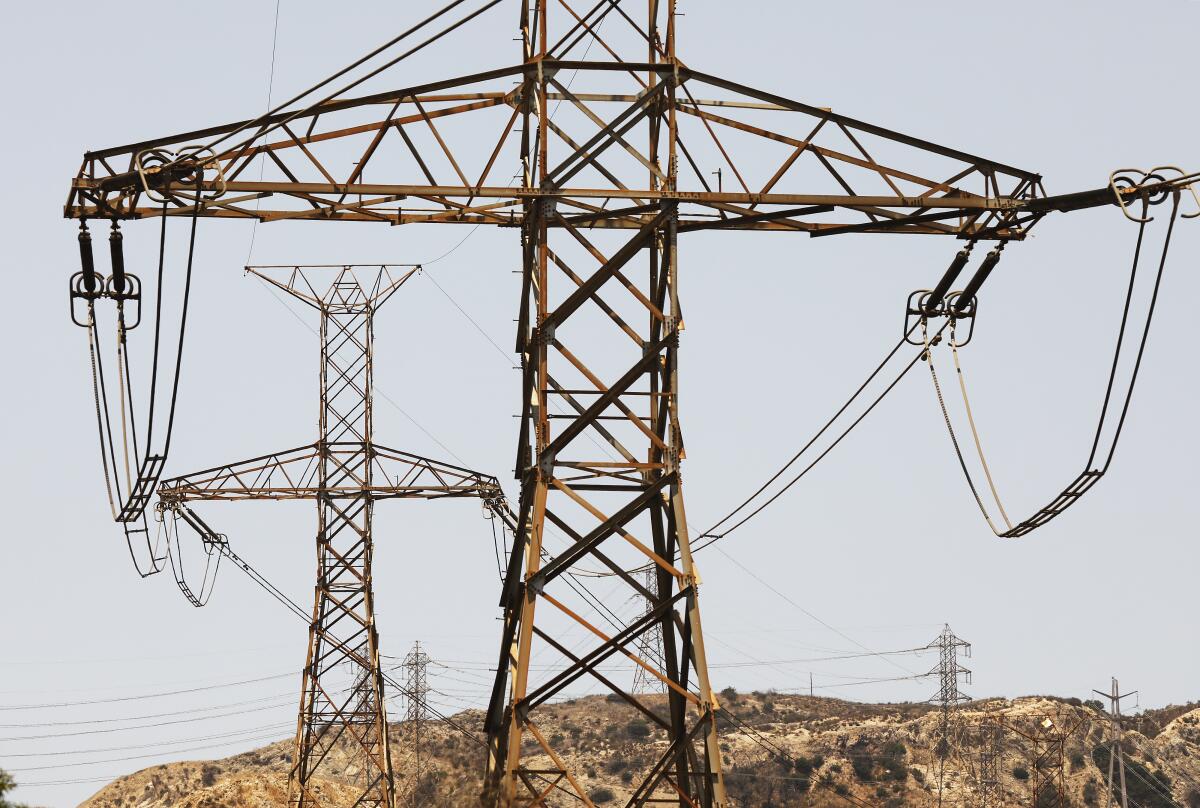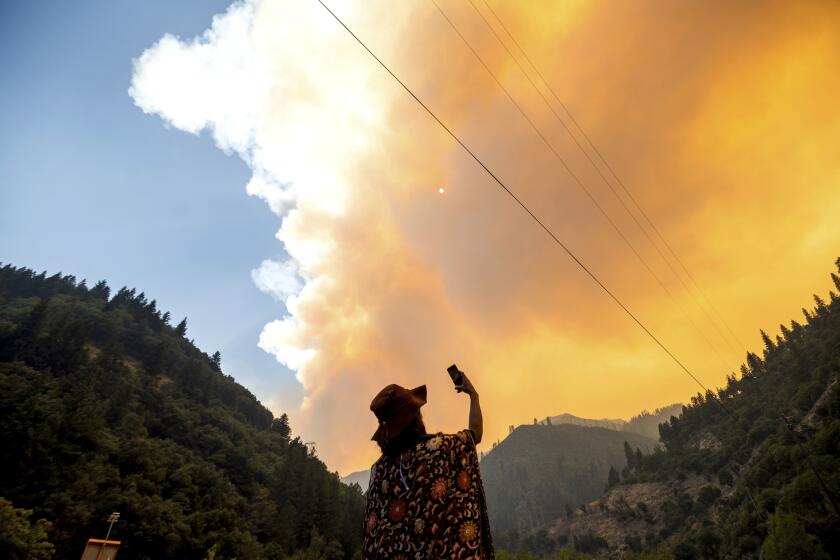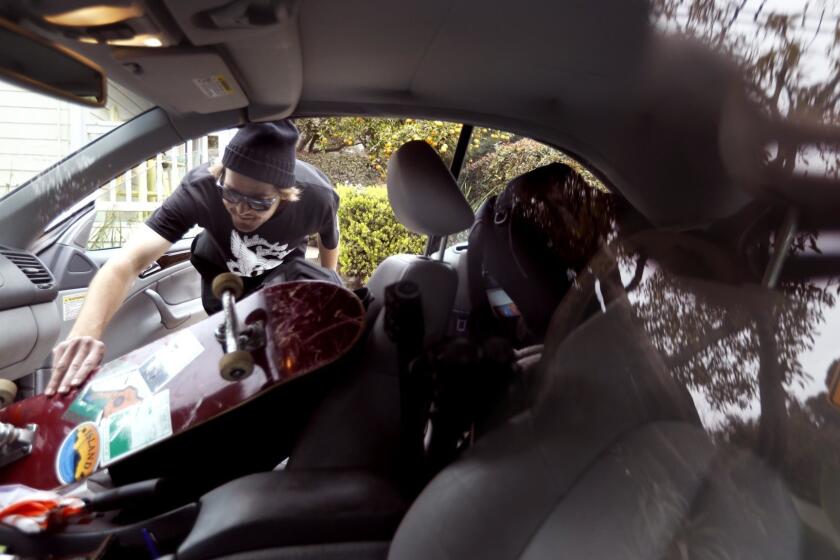Here’s how to prepare for a blackout in a heat wave

- Share via
As the deadly heat wave continues broiling the state, officials say Californians should be ready for rolling blackouts.
The California Independent System Operator is asking people to take any measures possible to reduce their power usage as much as possible starting at 4 p.m., when another Flex Alert goes into effect. That includes unplugging devices you aren’t using, turning the air conditioning to 78 degrees or turning it off, and holding off on running large appliances like your dishwasher and laundry machine until the power demand decreases.
Right now, usage is higher than ever as California contends with triple-digit heat in some areas.
“Electricity demand is currently forecast at more than 52,000 megawatts (MW), a new historic all-time high for the grid,” the agency said Tuesday. Residents should be “ready for potential rotating power outages on Tuesday evening, as the hottest weather of this historic heat wave is forecast to push electricity demand to an all-time high. If outages are initiated, consumers can expect to receive notifications from power providers on areas affected and time duration.”
That means it’s a good time to prepare to lose power. Check your flashlight batteries, prep a no-cook meal, and break out your puzzles and board games. Here’s what else you can do before, during and after a power outage.
When the state calls for a Flex Alert, you should try to conserve as much power as possible. Here are some ideas for saving energy.
Before
Emergencies happen. For a potential power outage — and any other natural or human-made disaster that may strike — you want to have your basic emergency readiness boxes ticked. Have your emergency kit supplies ready, including food, water, batteries, a fire extinguisher, cash, a hand-crank NOAA radio and a manual can opener (you can find a full list here). If you signed up for Unshaken, our earthquake preparedness newsletter series, a lot of this information is going to sound familiar. Being prepared for one kind of disaster will have you well equipped to handle any emergency that comes up.
Sign up for alerts from your electricity provider and bookmark its website’s map of outages. In a lot of Southern California, that’s going to be Southern California Edison, which has an outage map here and lets you sign up for alerts by email, text and phone here. In the city of Los Angeles, you can check the L.A. Department of Water and Power outage map here and click here for alerts. Here’s the outage map for San Diego Gas & Electric and how to download the app with alerts. And here’s where to find the outage map for Pacific Gas & Electric, which serves much of the rest of California, and where to sign up for those alerts.
If you have advance notice that you may lose power, there are things you can do to get ready to weather the outage.
- Fill up your gas tank or charge your electric car battery in case the outage lasts longer than expected and you have to travel somewhere else.
- Double-check that flashlights and smoke and carbon monoxide detectors have working batteries.
- Charge your phone and devices, along with an extra battery pack.
Plugging in a bunch of laptops, battery packs and phones to charge before a Flex Alert or planned outage goes into effect might sound counterintuitive to what you’re supposed to be doing when energy demand is already up. But it’s not, said Diane Castro, a spokesperson for Southern California Edison.
“Once the Flex Alert happens, that’s when you want to unplug the devices,” she said. “You can charge your phone before the Flex Alert. It’s during those Flex Alerts, those peak hours, that’s when you want to conserve energy.”
The same goes for your air conditioning: It’s fine to crank the thermostat to pre-cool your place, then turn it up to 78 or higher (or turn it off altogether) during the Flex Alert.
Anticipate what your power needs might be during the outage and figure out how to plan ahead:
- Learn how to manually open your garage door, or leave it open during the outage.
- If you have impaired mobility and use an elevator to get between floors, work with your household members or neighbors to figure out a plan to get you out of the building if needed.
- If you use electric medical devices, make sure they have fresh batteries and contact your doctor to discuss what to do if you lose power.
- If someone in your household needs to work or attend class, install apps like Zoom on your phone, or figure out how to use your phone as a Wi-Fi hot spot.
If you have a non-corded telephone on a traditional phone line, you’ll still be able to use it when the power is out. It’s a good idea to write down crucial phone numbers (doctor, neighbors, family members, maybe a co-worker or two) so you don’t need to rely on your smartphone when battery power is at a premium.
Make sure you have some fun things to do in your house that don’t need to be plugged in. Puzzles, board games, a deck of cards, arts and crafts, books, pillow fort materials — in other words, break out all the stuff you were doing in early quarantine when you were trying to avoid the news. And if mealtime is coming up, pick something that won’t require you to open and close the fridge or freezer a bunch of times.
How can you cool off if the power’s out? Here are tips for not melting when you lose power during a heat wave.
During
Use battery-operated light sources like flashlights and lanterns. Despite their moody allure, candles are a bad idea during a blackout, because they’re a fire hazard. It’s never a good time to start a fire in your house, but doing it when emergency services are probably already busy elsewhere is particularly unwise.
If you use your car to charge your phone or other electronics, make sure you aren’t doing it in a closed garage and risking carbon monoxide poisoning. A safer option is to buy a hand-crank radio for your emergency kit that also lets you charge phones and other devices. Speaking of carbon monoxide risk, another big don’t: Do not run a generator inside. Do not use a grill or propane stove or heater inside. Do not light a fire indoors.
Keep your refrigerator and freezer closed as long as possible. Every time you open them, you’re letting out cold air and getting closer to food spoiling, said Marilyn Jiménez, a regional communications manager for the American Red Cross Los Angeles Region. If you do get to the point where you need to access the food in there, know what you’re going to eat first and close the door ASAP.
“If you’re staying at home and there’s a prolonged outage, you want to use perishable food from the fridge first, then the freezer food,” she said. “Food is safe to eat when it has a temperature of 40 degrees Fahrenheit or below. Anything higher than that you want to throw out, especially dairy products. If the outage continues beyond a day, prepare a cooler with ice for your freezer items and keep it cool and covered at all times.”
Meals to make from canned food and a little seasoning ingenuity. These will make your earthquake emergency rations more palatable.
Don’t use your phone or laptop except for emergencies. Yes, it can be a struggle to keep a family entertained for hours at a time with no phones, video games, TV or music. But this is not a good time to blow through your phone battery listening to podcasts or playing Candy Crush. Reserve it for outage-related information only.
Keep an eye out for alerts from your electricity company. Tune in to an all-news radio station on your weather radio to listen for updates. In addition to your electricity company’s website, California ISO provides updates on its site and on Twitter.
If you had a bunch of lights on before the power went off, turn off all but one. That way, you’ll know when the power comes back, but you won’t be risking a surge that could blow out your appliances. In general, Castro said, it’s a good idea to unplug anything that isn’t plugged into a surge protector.
Don’t drive anywhere unless you absolutely have to, since the outage could affect traffic signals as well. In cases of extreme weather, know where you’ll go if you can’t stay home anymore. Most outages affect only small geographic areas, Castro said, so check to see whether there’s a friend or family member who still has power who can take you in. You can also look for cooling or warming centers in your area. Before you get to that point, make sure windows and blinds are closed and any cracks are sealed.
One key to getting through any emergency situation is preparation.
After
Hurray! The power is back on. It’s time to take stock.
Your main concern is making sure you and your family are safe, Castro said.
After that:
- Make sure appliances are working and nothing was affected by a power surge.
- Plug in anything you unplugged. Anything that was connected to a timer, like a plant grow light, probably needs to be reset.
- Check that the food in your fridge and freezer are still at safe temperatures (maximum 40 degrees Fahrenheit).
- Reconnect your garage door opener if you set it to manual.
- Stay away from power lines.
- Go through your emergency kit and add replacements for whatever you used to your grocery list.
- Check in on neighbors and nearby family and make sure everyone’s OK.
Then turn on some lights and relax. You made it.
About The Times Utility Journalism Team
This article is from The Times’ Utility Journalism Team. Our mission is to be essential to the lives of Southern Californians by publishing information that solves problems, answers questions and helps with decision making. We serve audiences in and around Los Angeles — including current Times subscribers and diverse communities that haven’t historically had their needs met by our coverage.
How can we be useful to you and your community? Email utility (at) latimes.com or one of our journalists: Jon Healey, Ada Tseng, Jessica Roy and Karen Garcia.











